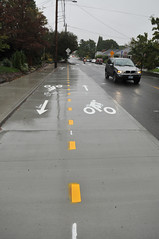A new study from Dr. Anne Lusk at the Harvard School of Public Health published in the British Medical Journal yesterday came to the conclusion that bicycling in a cycle track — physically separated from motor vehicle traffic — is safer than riding in the street.
“These data suggest that the injury risk of bicycling on cycle tracks is less than bicycling in streets.”
— From the study’s abstract
Why do we need a study proving that physical separation from things that can kill you leads to safer conditions? It’s my hunch that this study was done just as much to make a policy point about America’s current traffic engineering guidelines as it was to gather statistical data. Here’s a key excerpt from the study:
“Contrary to AASHTO’s [American Association of State Highway Transportation Officials] safety cautions about road-parallel paths and its exclusion of cycle tracks, our results suggest that two-way cycle tracks on one side of the road have either lower or similar injury rates compared with bicycling in the street without bicycle provisions. This lowered risk is also in spite of the less-than-ideal design of the Montreal cycle tracks, such as lacking parking setbacks at intersections, a recommended practice.”
And, in a section titled, “Implications for Policy,” researchers wrote:
“Public health and bicycling advocates in the USA have faced a dichotomy, believing from surveys and European experience that cycle tracks encourage more bicycling, yet being warned that they lead to higher crash and injury rates. Our results suggest that cycle tracks lessen, or at least do not increase, crash and injury rates compared with the street. The construction of cycle tracks should not be discouraged.
The study was conducted on cycle tracks in Montreal. Back in April 2007, then Portland City Commissioner (now Mayor) Sam Adams visited Montreal and his staffer Tom Miller (now PBOT Director) commented that he’d like to try their separated facilities in Portland.
Will this study end the debate here in the states about whether or not separated facilities are the best way forward? Maybe not. But it’s likely to add fuel to the fire of “Cities for Cycling” a collaboration of planners and engineers from major U.S. cities working to establish their own guidelines so they are able to construct a wider range of facilities — including ones that physically separate bicycles from motor vehicle traffic.
Risk of injury for bicycling on cycle tracks versus in the street was published in Injury Prevention by the British Medical Journal and is available for free on their website.



